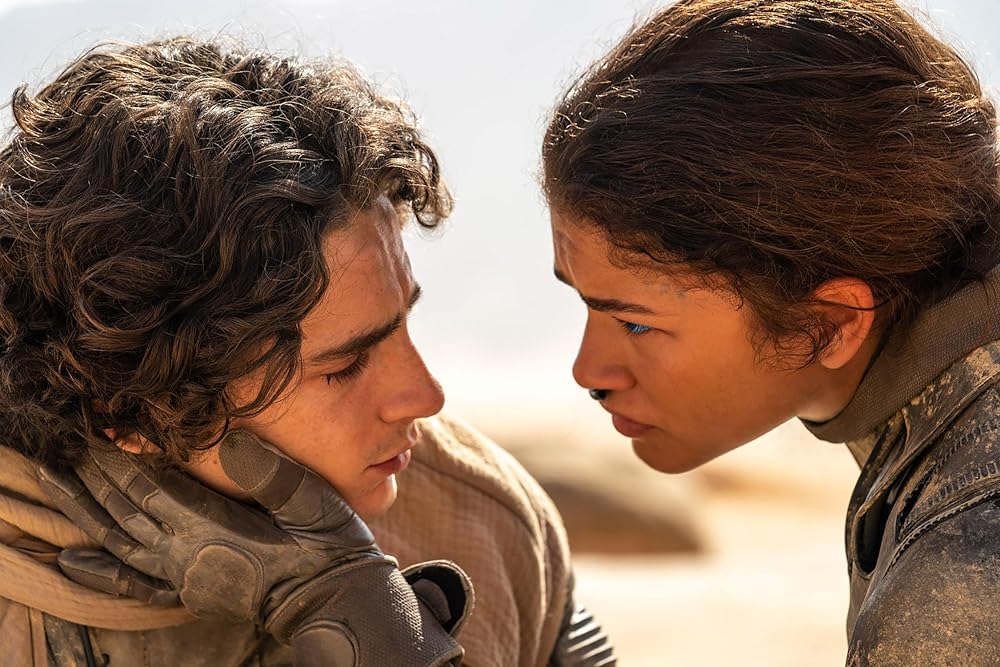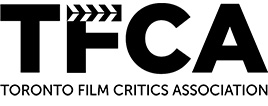Reviews include Sharp Corner, Clown in a Cornfield, and Caught by the Tides.
TFCA Friday: Week of March 1
March 1, 2024

Welcome to TFCA Friday, a weekly round-up of film reviews and articles by TFCA members.
ICYMI: We’re profiling the Rogers Best Canadian Film nominees ahead of our March 4 Gala. Check out interviews with BlackBerry’s Matt Johnson and Matt Miller (by Jennie Punter), Humanist Vampire Seeking Consenting Suicidal Person’s Ariane Louis-Seize (by Rachel Ho), and Solo’s Sophie Dupuis (by Rachel Ho).
In Release this Week
500 Days in the Wild (dir. Dianne Whelan 🇨🇦)
“Extraordinary moments come – face to face with wild horses, love notes found in tree fungus, not being eaten alive by bugs and a roaming bear, escaping massive forest fires, enduring deep freezes and an undercurrent of panic in the Lake Superior chapters – I’d be terrified on that deep cold ship’s graveyard too,” writes Anne Brodie at What She Said. “Whelan’s five cameras and a drone captured it all as she reached deep inside for the guts to accomplish her goal. What a film! What a woman!”
“500 Days in the Wild is a beautiful film that also displays the beautiful country of Canada in all its 4 seasons and terrain,” says Gilbert Seah at Afro Toronto. “Director Whelan also makes sure the message of getting connected with Mother Earth gets through to her audience.”
“It’s an epic achievement. Whelan, in her fifties and by her own admission not especially athletic, has become the first person to travel every kilometre of the Trans Canada trail,” observes Chris Knight at Original Cin. “And as a filmmaker who has documented others’ stories in the High Arctic and the base camp of Mount Everest, she knows a thing or two about extreme experiences. This one, mind you, is all hers. She’s just generous enough to share it with the rest of us.”
At POV Magazine, Pat Mullen speaks with director Dianne Whelan about how she connected with the land across her six-year journey and how 500 Days in the Wild was the project she’d been building towards her whole life. “Once I got into filmmaking, I started in the Arctic and then went to Everest, so my confidence level went up,” observes Whelan, likening the process to training in a gym. “My films begin as independent films, so they’re self-financed. I just go out there with my camera and away we go. You gain confidence when you go on these journeys and then you come back and the film gets made and released, and that muscle gets stronger. The preparation for this journey was everything that I’d been through on my life before I began it.”
About Dry Grasses (dir. Nuri Bilge Ceylan)
“It feels unbalanced, a collection of often-compelling sequences stitched together in a way that is unpersuasive or sometimes simply puzzling,” admits Liam Lacey at Original Cin. “At 197 minutes, About Dry Grasses is stretched out with interior scenes of circular conversations, outdoor scenes of snowy landscapes, including still photographs (Samet is an amateur photographer) of local people and the stark landscape.”
“Structured like a quietly grand novel, subtle and elliptical, Ceylan’s film unfolds with Chekhovian grace and a cutting understanding of character,” notes Barry Hertz at The Globe and Mail. “Through a half-dozen scenes of intricately choreographed dialogue – long, looping conversations whose naturalism belies their careful construction – the film builds a remarkably real, often uncomfortable world of thorny men and prickly philosophies. After an hour spent positioning him as a progressive intellectual undeserving of his rural plight, the film upends Samet to reveal the cynical snob that he is, while recontextualizing Kenan’s relative what-me-worry innocence and Sevim’s adolescent POV.”
Analogue Revolution: How Feminist Media Changed the World (dir. Marusya Bociurkiw 🇨🇦)
“[V]oices include [TFCA member] Susan G. Cole, who dishes about the history of Broadside Feminist Review. She looks back at the publication that allowed writers to do deep dives into stories about issues affecting women that mainstream publications—heck, even smaller ones—neglected to provide space for. Offering perspectives about the consequences of pornography, for example, let publications like Broadside expand the cultural conversation,” writes Pat Mullen at POV Magazine. “It’s refreshing to see the history told by the women who wrote it and lived it, many of whose endeavours weren’t as long lived as they should have been.”
Code 8: Part 2 (dir. Jeff Chan 🇨🇦)
At The Globe and Mail, Johanna Schneller speaks with director Jeff Chan and actors Robbie Amell and Stephen Amell about their follow-up to their crowd-funded hit: “Then Netflix licenses it, and the night before it premieres, we get a call from their PR team. They said, ‘Yf you don’t see the movie on the home page or top 10 list, don’t worry, it doesn’t mean people aren’t watching it,’” Robbie Amell tells Schneller. “At the end of day one we were number two, and at the end of day two, we were the number one movie on Netflix. They phoned us and said, ‘We heavily underestimated this movie.’ That was a cool call to get.”
“The film is a blend of sci-fi, action, super-hero action and drama and does not concentrate on any of these genres,” notes Gilbert Seah at Afro Toronto. “The film is a pleasant enough entertaining watch, suitable for the family with a possible message of the immense dangers of A.I. and the subject of effective policing in a community.”
Copa 71 (dir. James Erskine, Rachel Ramsay)
“Directors Rachel Ramsay and James Erskine (The Legend of Billy Jean King: The Battle of the Sexes) mine a trove of archival footage, including film of the actual games Mexico played (televised for the country’s passionate fans) which featured most of the teams and plenty of drama, including an all-out brawl,” writes Susan G. Cole at POV Magazine. “Not only were the players supported in the stadiums, they were followed diligently wherever they went in Mexico City, most notably at beauty salons; as players they were appreciated but they were also sexualized.”
At POV Magazine, Jason Gorber calls it a “powerful film that recovers a lost history of women’s sports” and speaks with directors James Erskine and Rachel Ramsay. “What was recognised by these Mexican businessmen was that this was something that could be successful because they weren’t part of the football establishment. They didn’t have the fundamental belief that women should continue to be excluded from the men’s growing sport,” says Ramsay.
Dune: Part 2 (dir. Denis Villeneuve)
“When all is said and done, the most urgent concern of Dune 2 is something everyone can relate to, whether they are sci-fi fans or not: Can the fragile love of Paul and Chani survive the chaos of their situation?” asks Peter Howell at the Toronto Star. “On a planet rife with death, betrayal and suffering, a resounding ‘yes’ to that question would be the greatest triumph of all, and a reason to hope that Villeneuve can make his triumphant Dune saga a trilogy.” Howell also speaks with Villeneuve about finding his groove in Hollywood. “For many years, I felt like a tourist in the room, trying to be invisible and having fun with the toys, and eating as much as I could of the buffet,” Villeneuve tells Howell. “But I felt welcome very quickly. And the more I spend time in that world, then the more I feel welcome and the more people want me to be part of the community. That touches me, to develop friendships with other filmmakers.”
“The efforts of Villeneuve and casting director Francine Maisler in selecting the younger actors needs to be acknowledged. While the likes of Chalamet, Zendaya, Pugh, Butler and Anya Taylor-Joy may seem like obvious choices given their popularity among both Gen Z and older audiences, by grouping these performers together, we get a glimpse of who will most likely be dominating the best Hollywood has to offer in coming years,” writes Rachel Ho at Exclaim!. “As they continue to develop as actors, Dune: Part Two will be remembered as the time when lightning struck and, somehow, all of them graced the same screen all at once.”
“While Villeneuve might carry a reputation for turning chilly source material into uncrackable permafrost – dating all the way back to his early Québécois work – he opens and then offers the entirety of his heart in Part Two. The rousing battle scenes in the final third would mean little without the director and his co-writer Jon Spaihts spending the previous two hours carefully establishing the trifecta of personal dramas plaguing Paul’s every move,” says Barry Hertz at The Globe and Mail. “But in terms of pure spectacle and shock-and-awe achievement, Villeneuve has produced an adaptation of mad glory and power. Long may he reign.” Hertz also speaks with Villeneuve about adapting Frank Herbert’s novel with a dark edge: “I made sure that in the screenplay I’ll have a character that will give us a perspective of Paul that we didn’t have in the book – that will deliver the idea that Paul is not the right figure, that he’s the anti-hero who in some ways is betraying the Fremen identity,” Villeneuve tells Hertz. “And that is Chani [played by Zendaya]. I worked a lot on her agenda, her goals, her needs, in order to have the audience understand that what’s happening at the end of this movie, it’s no happy ending.”
“There is a lot of plot in Dune: Part Two, which accounts for its running length of two hours and 46 minutes. And lots of terrific characters, well played. The women’s roles in Dune are especially strong with Zendaya and Ferguson as particular standouts,” remarks Karen Gordon at Original Cin. “But as it moves to its conclusion, what really hits are the undercurrents. The world of Dune is rife with secrecy and clandestine agendas. There are power struggles in every relationship that we see; people vying for power, for wealth, all tied to deeply felt and long held belief systems that keep them in a perpetual state of antagonism and war. Both Paul and Chani, in their way, are seeing through each other the potential of a different way to live.”
“It is hard to get excited watching 20 thousand CGI figures battling another 20 thousand CGI figures on the big screen,” admits Gilbert Seah at Afro Toronto. “The film’s most exciting part is the old-fashioned hand-to-hand combat (between Butler and Chamalet) at the end.”
“In Part One, the stumbling block was simple: a singular focus on exposition. Because of a need to get movie-goers up to snuff on whose crysknife pierced which Mentat’s stillsuit, we eventually arrive at the end with a better understanding of the characters and world — but at the expense of any fully realized character arc,” adds Jackson Weaver at the CBC. “Part Two feels similarly awe-inspiring but not quite finished, though for a different reason. It begins with Paul wandering the desert after a violent coup and attempt on his life by the Harkonnens. Forced to take refuge with the Fremen, he falls back on an old trick.”
“They say that the spice of Arrakis is highly addictive. Prolonged exposure to the famed melange of planet Dune reportedly heightens the senses. One can therefore assume that after spending so much time swirling in the sands of Dune and basking in the essence of Frank Herbert’s popular sci-fi world, Denis Villeneuve and company are regular spice fiends. So too is anyone, really, who’s committed themselves to being immersed in this world,” writes Pat Mullen at That Shelf. “Dune is a drug, but it has never delivered a high quite like it does in Part Two. This epic follow-up to Villeneuve’s 2021 Dune adventure offers bigscreen blockbuster entertainment of the highest order.”
My Name Is Loh Kiwan (dir. Kim Hee-Jin)
“The film depicts Loh’s very difficult and tiring defection process showing his impoverished living conditions, and the equally gruelling enrollment procedure for refugee status,” notes Gilbert Seah at Afro Toronto. “Mostly, the moving film credibly and effectively shows that life is not always dished out on a silver platter and one like Loh has to make do while taking one step at a time.”
The Parades (dir. Michihito Fujii)
“Though intriguing as the plot can be, the story also dwells on the stories of the others, which tends to eclipse the main story of Minnako,” says Gilbert Seah at Afro Toronto. “Unfortunately, there are too many other stories, and these including the story of Mink can hardly be described as terribly interesting. Director Fiji’s director character might be a reflection of his own character, but he comes across as a person too full of himself. His character is always able to get what he wants. Even the Yakuza gangster, the most interesting of all the dead characters follows his advice.”
Spaceman (dir. Johan Renck)
“Despite incidents occurring at a regular pace as the film progresses, the whole exercise involving the beginning and end of time and Jake’s realization for the failure of his marriage is a turgid affair,” sighs Gilbert Seah at Afro Toronto. “The introduction of Hanus the talking spider does not help either. No one is never sure what is happening or what could happen. The way life’s discovery and regrets for Jakub are realized is not convincing enough.”
“Languidly paced and smothered by a Hans Zimmer-lite score meant to push a kind of faux-profundity onto the proceedings, director Johan Renck’s film has a deadly serious tone that never feels justified,” yawns Barry Hertz at The Globe and Mail. “Colby Day’s script gives the game away early, too, when Jakub is asked by a little girl during a press teleconference what it’s like to be the loneliest man in the world. Being alone is hard, marriage is hard, dealing with space-spiders who have a taste for Nutella is hard, I guess. It doesn’t take another hour and a half to figure out where Jakub’s journey is going, which is of course nowhere at all.”
File Under Miscellaneous
At The Globe and Mail, Barry Hertz speaks with Canadian actor William Belleau about landing a role in Martin Scorsese’s Killers of the Flower Moon, persevering in Hollywood, and being part of a notably Indigenous ensemble. “I asked Leo, ‘You’ve done six projects with Marty – does it ever stop feeling like a dream?’ He said not at all. Tatanka Means is a really good friend of mine, so I was thrilled that he was there, and that we had the Indigenous cast that was there,” Belleau tells Hertz. “There was a brotherhood and sisterhood that occurred between us all. We would barbecue together. This was a life-changing thing, and we experienced it together.”
At POV Magazine, Pat Mullen speaks with Oscar winner and Halifax native Ben Proudfoot about his latest nominee The Last Repair Shop, which shares the stories of employees in a Los Angeles repair shop for musical instruments and the students whose lives they transform. “It underlines how everybody has a story,” Proudfoot tells Mullen. “This was not an extensive casting research project,” he continues. “These are just the four people who decided that they wanted to tell their story. Dana was the first one I spoke to, and it became clear immediately to Kris and I that the overarching metaphor was of the physical instruments being repaired, but also that music could repair a person—that you could be broken and repair your life. As soon as that came forward, we were like, ‘That’s the movie.’ These people are heroes reminding us to approach everything in life as if it can be repaired.”
At The Globe and Mail, Barry Hertz Dune: Part Two reports that the popularity of has Cineplex charging surge pricing for tickets as if they’re Uber drivers on New Year’s: “At a number of Cineplex locations, a general admission ticket for Dune: Part Two will cost $1 more this weekend than a ticket for any other title. At the Cineplex Cinemas Yonge-Eglinton location in Toronto, for instance, a general admission ticket for the sequel costs $15.25 before taxes or online surcharge. A ticket for the new comedy Drive-Away Dolls – in the same type of cinema, at the same time of day – runs $14.25,” writes Hertz.
A Festival of Festival Coverage
At What She Said, Anne Brodie highlights some films at the Kingston Canadian Film Festival including The Movie Man: “Documentarian Matt Finlin’s endearing, maddening, sympathetic, and intimate portrait of a visionary, The Movie Man, his 48 cats, and seasonal staff catches us off guard in the best way. What drives him to dedicate himself to showing movies? A maze of a museum of movie props, particularly horror and kitsch, books, magazines, archival materials, and oddball items spellbind guests before they sit to enjoy a first run or important prior release, and he gets a cheer after introducing the night’s film.
TV Talk/Series Stuff
At What She Said, Anne Brodie recommends The Completely Made-Up Adventures of Dick Turpin: “a riot of hilarity, bon mots, comic misunderstandings, physical humor, highly unlikely and yet somehow very Turpin twists and turns,” says Brodie. Meanwhile, the NFB workplace study Work Different offers “a few of the fascinating findings of a truly landmark change in the way we live.” Agatha Christie’s Murder Is Easy, on the other hand, is appropriately “easy comfort viewing.”



